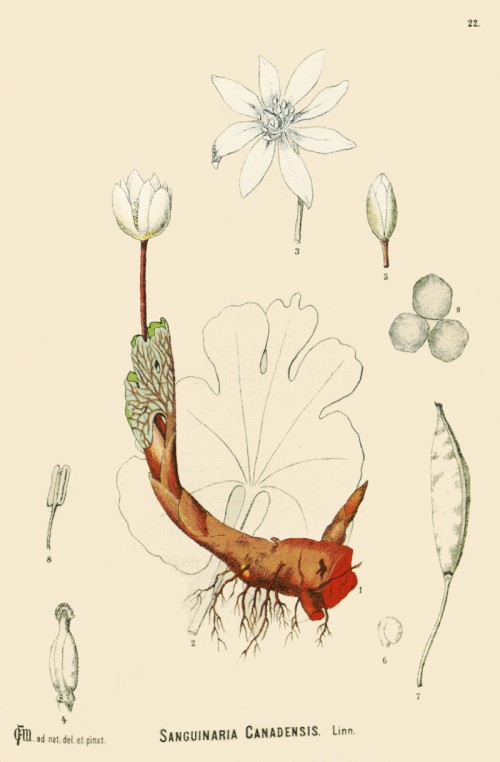Sanguinaria canadensis L. - Papaceraceae: - bloodroot, red pucoon, Amerikanische Blutwurz
Perennial herb, up to 40cm tall, native in Northern America, also cultivated; rhizomes branching; leaves blue-green, palmately 5-7-lobed, orbiculate-reniform to cordate-sagittate in shape; flowers solitary, white or pinkish, flowering earliest spring; capsule fusiform, 3.5-6cm; seeds black to red-orange.
„Although bloodroot is an ingredient of some compound cough remedies, it contains the poisonous alkaloid sanguinarine, and the U.S. Food and Drug Administration has characterized Sanguinaria canadensis as an unsafe herb (J. A. Duke 1985). Native Americans used it medicinally to treat ulcers and sores, croup, cramps, burns, tapeworms, fevers, diarrhea, and irregular periods, in cough syrups, as a spring emetic and blood purifier, to stop vomiting, and as a love charm, as well as in cermonial face paint (D. E. Moerman 1986).“
http://www.efloras.org/florataxon.aspx?flora_id=1&taxon_id=220011939
„In isolated, isometrically contracting left guinea pig atria, sanguinarine, a benzophenanthridine alkaloid from the papaveracea Sanguinaria canadensis, produced a concentration-dependent positive inotropic effect. Between 2.3 × 10−6 M and 6.5 × 10−5 M, sanguinarine increased contractility by 108% which was comparable to the maximal inotropic effect of ouabain. Within the same concentration range, sanguinarine caused inhibition of Na+,K+-ATPase isolated from guinea pig myocardium. 100% inhibition of Na+,K+-ATPase activity occurred at 1 × 10−4 M sanguinarine. The I50 for enzyme inhibition and the ED50 for the inotropic action of sanguinarine were the same (6–6.5 × 10−6 M) indicating that both effects may be causally related.“
[Sanguinarine: a positive inotropic alkaloid which inhibits cardiac Na+, K+-ATPase., Seifen, E., Adams, R.J., Riemer, R.K., European journal of pharmacology, 60(4), 1979, 373-377]
„A sanguinaria-containing toothpaste and oral rinse regimen was evaluated during a 6-month period to determine its effectiveness in controlling plaque, gingival inflammation, and sulcular bleeding… The sanguinaria regimen reduced plaque by 57%, gingival inflammation by 60%, and sulcular bleeding by 45% from baseline compared with placebo group reductions of 27% (plaque) and 21% (gingival inflammation), and an increase of 30% in bleeding index… the combined use of the sanguinaria-containing toothpaste and oral rinse controls and reduces plaque and gingival inflammation in an orthodontic population.“
[Long-term clinical evaluation of toothpaste and oral rinse containing sanguinaria extract in controlling plaque, gingival inflammation, and sulcular bleeding during orthodontic treatment., Hannah, J.J., Johnson, J.D., Kuftinec, M.M., American Journal of Orthodontics and Dentofacial Orthopedics, 96(3), 1989, 199-207]
„… berberine and sanguinarine intercalate DNA, inhibit DNA synthesis and reverse transcriptase. In addition, sanguinarine (but not berberine) affects membrane permeability and berberine protein biosynthesis. In consequence, these biochemical activities may mediate chemical defence against microorganisms, viruses and herbivores in the plants producing these alkaloids.“
[Biochemical activities of berberine, palmatine and sanguinarine mediating chemical defence against microorganisms and herbivores., Schmeller, T., Latz-Brüning, B., Wink, M., Phytochemistry, 44(2), 1997, 257-266]
„The rhizome extracts, as well as a methanol extract of S. canadensis suspension-cell cultures inhibited the growth of H. pylori in vitro, with a MIC50 range of 12.5–50.0 µg/ml. Three isoquinoline alkaloids were identified in the active fraction. Sanguinarine and chelerythrine, two benzophenanthridine alkaloids, inhibited the growth of the bacterium, with an MIC50 of 50.0 and 100.0 µg/ml, respectively.“
[In vitro susceptibility of Helicobacter pylori to isoquinoline alkaloids from Sanguinaria canadensis and Hydrastis canadensis., Mahady, G.B., Pendland, S.L., Stoia, A., Chadwick, L.R., Phytotherapy Research, 17(3), 2003, 217-221]
The dried rhizome, with roots removed (Sanguinariae canadensis rhizoma), is traditionally used (infusion) as an emetic, expectorant and spasmolytic to treat bronchitis, asthma, cough, croup, laryngitis and pharyngitis. Most common modern use is (as extract in mouth rinses and toothpaste) to conteract dental plaque and gingivitis. „Since sanguinarin and some of the other alkaloids can intercalate DNA, they are potential mutagens. There is new evidence that prolonged use in oral hygiene products may be harmful.“
[Medicinal Plants of the World. Ben-Erik Van Wyk and Michael Wink, Pretoria 2004, 286]
Sanguinarine has recently been shown to exhibit potent anti-MRSA activity in vitro by disrupting the cytoplasmic membrane of MRSA. „The activity of sanguinarine against MRSA strains ranged from 3.12 to 6.25 µg/ml, while the minimum inhibitory concentrations of the two reference strains are 3.12 µg/ml and 1.56 µg/ml. The treatment of the cells with sanguinarine induced the release of membrane-bound cell wall autolytic enzymes, which eventually resulted in lysis of the cell.“
[The mechanism of action of sanguinarine against methicillin-resistant Staphylococcus aureus., Obiang-Obounou, B.W., Kang, O.H., Choi, J.G., Keum, J.H., Kim, S.B., Mun, S.H., Kwon, D.Y. The Journal of toxicological sciences, 36(3), 2011, 277-283]
„The first crystal structures of Berberine and Sanguinarine intercalated with a d(CGTACG)2 DNA sequence were obtained by X-ray diffraction analysis at 2.3 Å resolution. Both drugs join the end of two “two-molecules” DNA units, stacked in a non-classic intercalation site formed by six bases. Sanguinarine interacts with d(CGTACG)2 DNA in its iminium form.“
[X-Ray diffraction analyses of the natural isoquinoline alkaloids Berberine and Sanguinarine complexed with double helix DNA d (CGTACG)., Ferraroni, M., Bazzicalupi, C., Bilia, A.R., Gratteri, P., Chemical Communications, 47(17), 2011, 4917-4919]

Millspaugh,C.F., American medicinal plants, vol.1, t.22 (1892)
http://plantgenera.org/species.php?id_species=904722